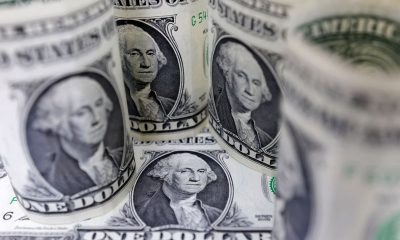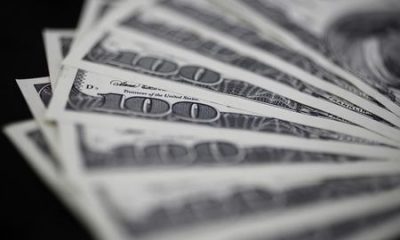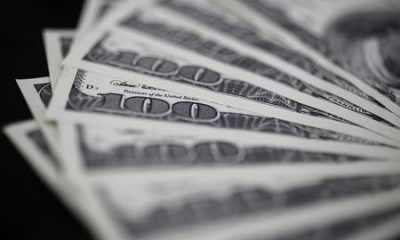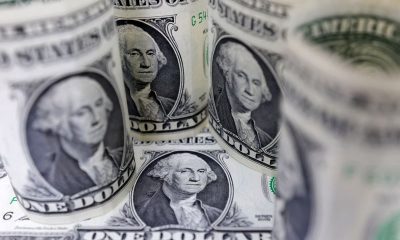Forex
King dollar seen vulnerable in 2024 if Fed pivots


© Reuters. FILE PHOTO: A man wears U.S. dollar sign rings in a jewellery shop in Manhattan in New York City November 6, 2014. Picture taken November 6, 2014. REUTERS/Mike Segar
2/2
By Saqib Iqbal Ahmed
NEW YORK (Reuters) -The Federal Reserve’s dovish December pivot has boosted the case for the weakening dollar to keep falling into 2024, though strength in the U.S. economy could limit the greenback’s decline.
After soaring to a two-decade high on the back of the Fed’s rate hikes in 2022, the U.S. currency has been largely range-bound this year on the back of resilient U.S. growth and the central bank’s vow to keep borrowing costs elevated.
The dollar was on track for a 2% loss this year against a basket of its peers, its first yearly decline since 2020.
The December Fed meeting marked an unexpected shift, after Chairman Jerome Powell said the historic monetary policy tightening that brought rates to their highest level in decades was likely over, thanks to cooling inflation. Policymakers now project 75 basis points of cuts next year.
Falling rates are generally seen as a headwind for the dollar, making assets in the U.S. currency less attractive to yield-seeking investors. Though strategists had expected the dollar to weaken next year, a faster pace of rate cuts could accelerate the currency’s decline.
Still, betting on a weaker dollar has been a perilous undertaking in recent years, and some investors are wary of jumping the gun. A U.S. economy that continues to outperform its peers could be one factor presenting an obstacle for bearish investors.
The Fed’s aggressive monetary policy tightening, along with post-pandemic policies to boost U.S. growth, “fueled the notion of American exceptionalism and delivered the most powerful dollar rally since the 1980s,” said Kit Juckes, chief FX strategist at Societe Generale (OTC:).
With the Fed set to ease policy, “some of those gains should be reversed,” he said.
FADING STRENGTH?
Getting the dollar right is key for analysts and investors, given the U.S. currency’s central role in global finance.
For the U.S., a weak dollar would make exports more competitive abroad and boost the profits of multinationals by making it cheaper to convert their foreign profits into dollars. About a quarter of companies generate more than 50% of revenues outside the U.S., according to FactSet data.
An early December Reuters poll of 71 FX strategists showed expectations for the dollar to fall against G10 currencies in 2024, with the greater part of its decline coming in the second half of the year.
Whether they’re right may come down to how the U.S. economy performs compared to its global peers next year and the pace at which central banks adjust monetary policy.
So far, it’s been an uneven picture. In the eurozone, a downturn in business activity deepened in December, according to closely watched surveys that show the bloc’s economy is almost certainly in recession. Still, the European Central Bank has pushed back against rate cut expectations as it remains focused on fighting inflation. The euro is up more than 3% against the dollar this year.
The “growth slowdown is more entrenched in other economies,” said Thanos Bardas, senior portfolio manager at Neuberger Berman, who is bullish on the dollar over the next 12 months. “For the U.S. it will take a while for growth to slow down.”
Others, however, see areas of strength, particularly in Asian economies. Paresh Upadhyaya, director of fixed income and currency strategy at Amundi US, says he believes the market is “way too pessimistic” on the outlook for growth in China and India. Accelerating growth could boost the countries’ appetite for raw materials, benefiting commodity currencies such as the Australian, New Zealand and Canadian dollars.
China will step up policy adjustments to support an economic recovery in 2024, according to state media reports.
Jack McIntyre, portfolio manager at Brandywine Global in Philadelphia, is counting on U.S. growth slowing while Chinese growth picks up. He has been selling the dollar to fund the purchase of Asian currencies.
“The dollar’s bull run is very mature,” he said.
The International Monetary Fund in October forecast the U.S. economy would grow by 1.5% in 2024, compared to 1.2% for the eurozone and 4.2% for China.
Of course, the dollar’s trajectory could depend on how much Fed easing and falling inflation is already reflected in its price. Futures tied to the Fed’s policy rate show investors factoring in more than 150 basis points in cuts next year, about twice as much as Fed policymakers have penciled in.
“If inflation stalls and does not continue to decline that’s where the case grows for the Fed to hold off,” said Matt Weller, head of market research at StoneX. “That would certainly be a bullish development for the dollar.”
Forex
BofA sees potential for further USD selling by CTAs
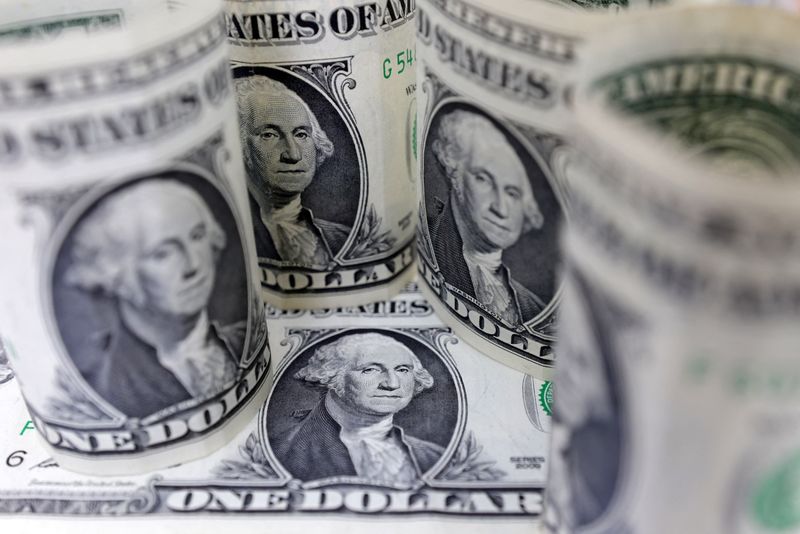
On Monday, Bank of America (BofA) provided insights into the potential actions of Commodity Trading Advisors (CTAs) in the coming week.
According to BofA, CTAs might continue to sell the U.S. dollar (USD) against most currencies following a trend that emerged after the Consumer Price Index (CPI) report led to a weakening dollar. The bank’s models indicate that USD long positions have been reduced this week.
The bank’s analysis suggests that in the foreign exchange (FX) market, CTAs are likely to persist with short covering in the euro (EUR), British pound (GBP), and Canadian dollar (CAD).
Additionally, there is an expectation for CTAs to increase their recently established long positions in the Australian dollar (AUD) and potentially initiate a long position in the Mexican peso (MXN), given the positive trend strength for the peso.
In the commodities sector, despite an increase in the price of gold last week, the trend for the precious metal declined, prompting CTAs to sell, albeit at a slower pace. BofA anticipates that this trend of selling gold and oil will continue into the next week.
The analysis also noted that CTAs’ long positions in are nearing extremely high levels, while long positions in aluminium are being unwound. In contrast, soybeans are experiencing short covering.
The bank’s report serves as a gauge of how trend-following traders might adjust their portfolios in response to market movements.
This article was generated with the support of AI and reviewed by an editor. For more information see our T&C.
Forex
BofA sees further dollar depreciation, expects G10 FX to stay in range
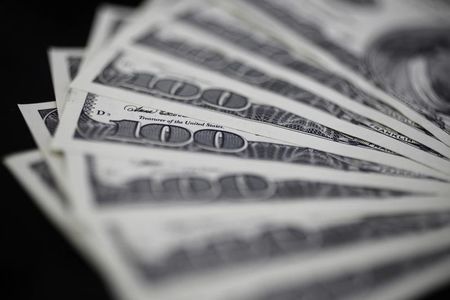
On Monday, Bank of America (BofA) analysts provided insights into the current state of G10 foreign exchange (FX) markets, noting a general sentiment of disappointment among investors due to the markets’ lack of volatility.
Despite a recent reversal in the U.S. dollar (USD), major currency pairs have not moved significantly, staying within their established ranges. BofA anticipates further depreciation of the USD, yet it emphasizes that the currency’s movements are expected to remain close to year-end consensus forecasts.
The analysis highlighted that while markets have expressed a desire for more excitement in G10 FX trading, they must come to terms with the inherent trade-off between carry trade opportunities and higher volatility. Carry trades, where investors borrow in low-yielding currencies to invest in higher-yielding ones, have been identified as a dominant trend post-global financial crisis.
However, this strategy tends to reduce market volatility, leading to what BofA describes as an “uninspiring” and “stuck in the mud” trading environment.
BofA’s commentary suggests that the pursuit of carry as a passive strategy has been a factor in dampening volatility in the FX markets. The firm underscores that investors should not expect both high carry returns and high volatility, as these market conditions are typically mutually exclusive. The lack of clear fundamental trends in G10 FX has been a source of frustration for markets, but the current trend of carry is clear, even if it leads to lower volatility.
The analysts also touched upon the anticipation around the next batch of U.S. data, which many investors hope might shift the narrative. However, BofA indicates that such expectations may be overly optimistic. The firm’s message to the markets is to adjust expectations and accept the current dynamics, with the USD continuing to play a central role in the G10 FX space.
In summary, BofA’s analysis points to a continuation of the recent patterns in G10 FX markets, with a slight downward trend in the USD value but within the bounds of recent trading ranges.
This article was generated with the support of AI and reviewed by an editor. For more information see our T&C.
Forex
Narrow dollar range likely to remain for now – Goldman
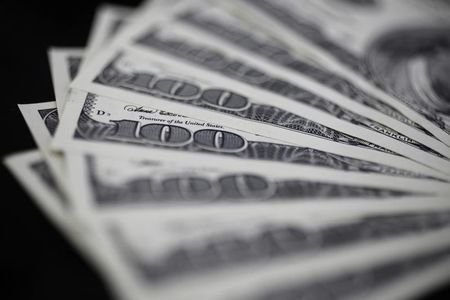
Investing.com – The U.S. dollar is trading in a calm fashion against the majors of late, and these narrow ranges will likely stay for a while longer, according to Goldman Sachs, with divergence having to wait.
AT 05:20 ET (09:20 GMT), the Dollar Index, which tracks the greenback against a basket of six other currencies, traded unchanged at 104.330, steadying after losing around 1% last week in the wake of soft U.S. inflation data.
“We think there is only limited room for the market to press Dollar shorts on the back of the inflation news,” said analysts at Goldman Sachs, in a note dated May 17.
“After all, while the prints were mostly in line with expectations, they were not in line with the target. As a result, the news does not change the policy outlook much beyond reinforcing the recent rhetoric.”
The subsequent market response has been reminiscent of the post-March FOMC FX reaction, when the response to ‘dovish dots’ stalled not because of fresh data, but instead because FX is still a relative game, and the Dollar fundamentals have not shifted much, the investment bank added.
And, this time around, we think the rally in front end rates looks more consistent with cyclical concerns rather than dovish expectations.
“That matters for FX because there is a narrow path for the Dollar to depreciate on a broad basis when growth is softening,” the bank added. “This is especially true in the current environment when faster Fed cuts would likely be met with easier policy abroad as well.”

 Forex2 years ago
Forex2 years agoForex Today: the dollar is gaining strength amid gloomy sentiment at the start of the Fed’s week

 Forex2 years ago
Forex2 years agoHow is the Australian dollar doing today?

 Forex1 year ago
Forex1 year agoUnbiased review of Pocket Option broker

 Forex2 years ago
Forex2 years agoDollar to pound sterling exchange rate today: Pound plummeted to its lowest since 1985

 Cryptocurrency2 years ago
Cryptocurrency2 years agoWhat happened in the crypto market – current events today

 World2 years ago
World2 years agoWhy are modern video games an art form?

 Stock Markets2 years ago
Stock Markets2 years agoMorgan Stanley: bear market rally to continue

 Economy2 years ago
Economy2 years agoCrude oil tankers double in price due to EU anti-Russian sanctions

